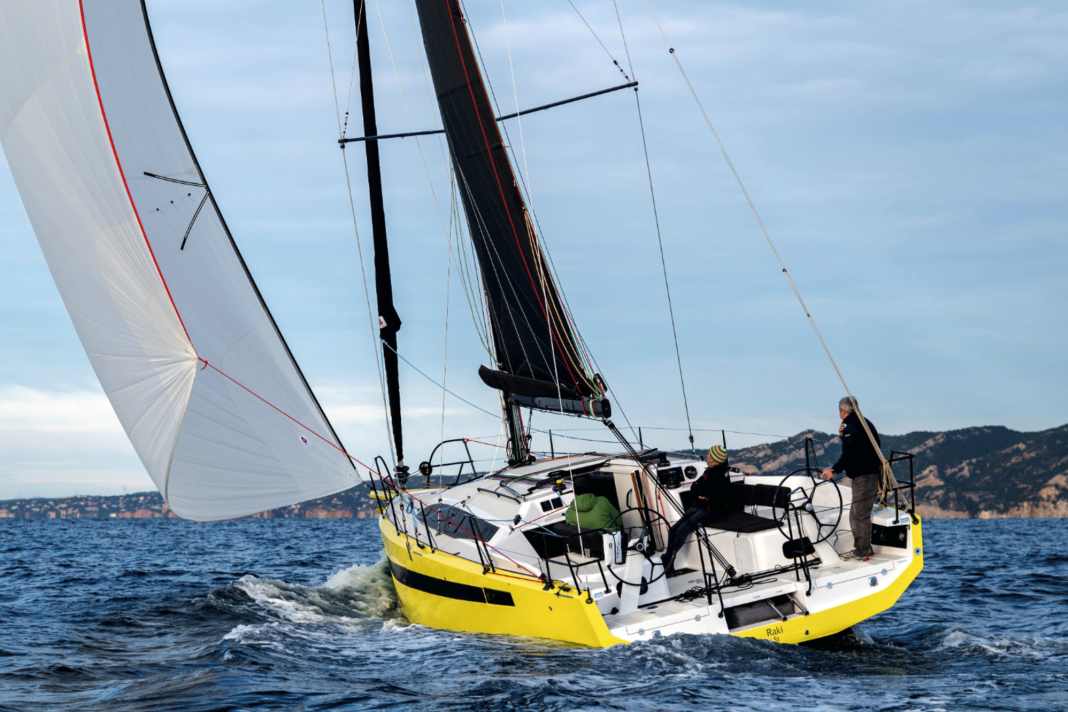





- Building material determines hull shape of the RM 1080
- The RM 1080 features a revolutionary cockpit
- No swivelling keel for the RM 1080
- The RM 1080 under sail
- Proven operation
- The RM 1080 below deck
- The price of the RM 1080
- YACHT rating
- Technical data RM 1080
- The competition of the RM 1080
Plywood is an indispensable material in the construction of almost every yacht. The multi-laminated plywood is mainly used for the production of bulkheads and furniture components, usually with surfaces made from veneers of different woods. However, the construction of complete boats from plywood is rare. However, the French shipyard RM Yachts sticks to this material out of tradition and conviction, at least when it comes to building the hulls, as is the case with the RM 1080.
Plywood not only impresses with its low weight, robustness and durability, but also with its significantly more environmentally friendly production compared to fibre-reinforced plastic, for example. And the issue of osmosis is also a thing of the past. Another advantage is that the plywood hulls have to be painted afterwards. Here, RM Yachts customers can choose from over 210 possible colours - just like when buying a car. So it doesn't necessarily have to be yellow like the RM 1080 in the pictures.
Read also: The big comparison test of performance cruisers...
Building material determines hull shape of the RM 1080
With this exotic construction method, however, the buckling frame cannot be avoided. As plywood can only be bent and moulded to a limited extent, the distinctive edges inevitably remain. Visually, the multi-buckling frames from RM Yachts therefore stand out clearly. Despite many ecological principles, the shipyard relies on a GRP deck for its yachts. This is produced as a sandwich construction using the vacuum infusion process. Plywood is simply not suitable for decks, as the shapes are too angular and the individual surfaces are generally too small.
Following economic difficulties and insolvency proceedings in 2019, RM Yachts is now part of the French shipyard conglomerate Grand Large Yachting, which also includes the Allures, Garcia, Outremer, Gunboat and ORC brands. On this solid foundation, the yacht builders in Périgny near La Rochelle can take off again and develop innovative models under new management.
The RM 1080 features a revolutionary cockpit
The latest boat in the series is the extremely exciting RM 1080, with which the shipyard surprisingly departs from the previous cockpit design and presents a revolutionary new layout. The high coamings of the new boat are extended from the cabin bulkhead all the way to the outside of the hull. This opens up the cockpit across the entire width of the boat. The thwarts are designed as generous 1.25 metre wide areas. Thanks to removable backrests, they can be used both as conventional benches and - with additional cushions - as comfortable sun loungers. A completely new approach that offers a wide range of possible uses.
Modified walkaround
The shipyard has dispensed with a continuous running deck on the sides of the RM 1080. The route to the foredeck therefore leads over the wide dents and requires a larger step over the wide moulded coaming. Steps make it easier to climb up from the helm. RM has thus adopted the idea of the walkaround cockpit, albeit in a slightly modified form, and is thus following a trend: the search for the optimum cockpit.
In practical tests, the new cockpit design proves to be very functional. Anyone moving around the boat naturally accepts the small diversions around the steering columns at the stern. However, the helmsman only has a minimalistically small seat to the side, which can be uncomfortable and tiring in the long run.
No swivelling keel for the RM 1080
The shipyard will no longer offer a swivelling keel for the RM 1080 and future models. Until now, the flexible hull appendage, which allows the keel to be swivelled longitudinally under the hull, was a trademark of RM Yachts. However, the reasons for this step are clear: the swivelling keel is too complicated, too costly, prone to defects and ultimately too expensive for customers. Instead, the version with two bilge keels (1.74 metres draft) and a rudder blade with base plate remains the standard. This allows the boat to be parked on three points without any problems.
The bilge keel is also available with two rudder blades, especially for areas where falling dry is not an issue. Another advantage: with the two keels, the boat is very stable in the water and tends to rock less, which is a particular advantage when anchoring. As an alternative, RM Yachts offers the RM 1080 with a fixed keel and lead bomb. In this version, the boat is always equipped with two rudder blades and is around 400 kilograms lighter. To ensure a strong bond between the keel and plywood hull, RM uses a robust galvanised steel frame for all boats.
The RM 1080 under sail
The large bay of Marseille in the south of France offers ideal conditions for the YACHT test: offshore winds of eight to ten knots and correspondingly moderate waves. Hard on the wind with a genoa, the RM 1080 easily manages a speed of 6.1 knots and sails at a decent height with an angle of 40 to 45 degrees to the true wind. Under gennaker and from a wind angle of 90 degrees, the construction from Marc Lombard Yacht Design can easily reach speeds of just under eight knots. The performance potential is quite impressive for a cruising boat with sporting aspirations.
Balanced in the wind
Upwind, the RM 1080 with its two rudder blades has balanced sailing characteristics. The rudder pressure remains minimal, however, and the boat reacts immediately and quite dynamically to movements at the helm. Under gennaker, the boat even behaves slightly leeward, which can be a little uncomfortable. So if you want to sail with maximum performance, you have to steer very carefully. A comparison of the polar diagrams shows that the boat with a fixed keel should be slightly faster than the chine keel, especially in lighter winds. However, the delta is barely higher than 0.3 knots.
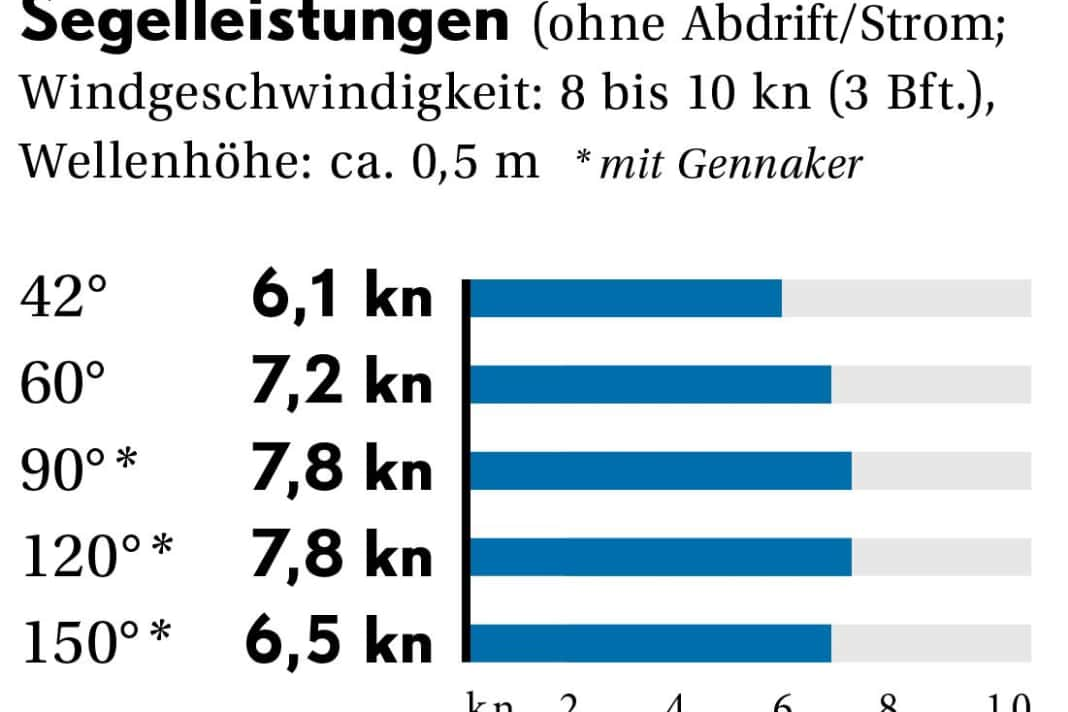


No self-tacking jib
The yellow test boat, build number two of the current series, is equipped with a carbon fibre rig, which ensures high stability and low weight at the same time. All shrouds are also made of an innovative Dyneema construction and together weigh just seven kilograms. In combination with the wardrobe upgrade, this should have a positive effect on sailing performance. However, a self-tacking jib is not possible due to the large panoramic windscreen in the cabin superstructure in front of the mast. For longer journeys at sea, the boat can be optionally equipped with a stay jib and additional backstays. The necessary fittings on deck are already included as standard.
Proven operation
For the layout of the trim functions and for guiding the lines, RM continues to rely on typical brand habits. This means: halyards and trim lines as well as the mainsheet run back over the cabin superstructure to the two winches on the companionway. For the genoa and gennaker sheets, there are two more winches, set back and slightly lower. They are mounted on separate platforms and can be operated efficiently from a good height while standing. However, the 40 mm halyard winches are a little too small to cope with the high loads.
Not suitable for one-handed use
With a small crew of two or three people, this arrangement works very well. However, the helmsman works in isolation in his area behind the wheel and cannot reach any other functions apart from the traveller and the backstay. The boat is therefore no longer suitable for single-handed sailing. This is why the autopilot is a mandatory part of the basic equipment, but is only available as an option as part of the electronics package. Incidentally, as is often the case, the steering works with only one continuous cable to the two rudder blades and is not redundant. As the autopilot acts directly on the quadrants, it could take over control in the event of a failure. This provides additional safety.
The RM 1080 below deck
Below deck, the sober, almost clinical interior design catches the eye. Anyone who thinks there is a lack of wood here is wrong. The interior of the RM 1080 is also completely lined with plywood. However, the surfaces are painted and are flawless. The customer also has a free choice of colours in combination with the variants for the upholstery and floorboards. This offers a great deal of visual individuality. The cabin roof is also clad with an inner shell made of plywood. The panels are mounted at a distance from the GRP deck, ensuring good ventilation and insulation.
Bright and cosy
The open, bright design of the test boat is very pleasant and cosy and creates an almost Mediterranean ambience. In addition, the interior surprises with an unusually large amount of light coming in through the large window strips in the superstructure and hull and, above all, through a panoramic window through which you can also look ahead from inside and while standing and even check the position of the genoa. In bad weather, the boat can be steered from inside with a remote control for the autopilot.
Only one expansion version
The shipyard only has one version without alternatives for the extension. The owners sleep quite comfortably in the foredeck. However, due to the short cabin superstructure, the headroom in front of the main bulkhead is just 1.67 metres. And the door frame is only 1.48 metres high at the passageway from the saloon to the foredeck. You have to duck your head here to get through without damage. That takes some getting used to.
Cramped bunks
In addition, the 1.40 metre wide berth in the foredeck in the shoulder area is rather tight for two people. The shipyard has given away bunk space here in favour of open, flat shelves, which are only of limited use anyway. The bed in the aft cabin on the port side is also only 1.40 metres wide.
Large extra room
There is an open storage and technical room on the starboard side. Sailors who spend a lot of time on the boat and plan longer trips will appreciate this offer, as almost everything can be stowed here, including larger items. The space can also be used as a walk-in workshop.
However, the large cockpit locker is only accessible from the inside through the wet room, but unfortunately not directly from the cockpit to stow bulky items such as the additional sails. The reason: the shipyard wants to keep the technical area dry at all costs and at the same time eliminate the risk of water ingress on the high seas.
The price of the RM 1080
With the new RM 1080, the French have once again added another exciting competitor to the popular eleven metre hull length class, offering an exotic but all the more attractive alternative. The boat delivers a lot for a fair and competitive price. And it can also set itself apart from the competition thanks to its rare and high-quality construction. RM Yachts therefore offers the individuality that many customers are looking for. And the arguments regarding sustainability and ecology in yacht building could also play a role for many interested parties.
- Base price ex shipyard 297.500 €
- Price ready to sail308.150 €
- Comfort price 344.285 €
- Guarantee 2 years
As of 12/2024, how the prices shown are defined, read here!
YACHT rating
Attractive performance cruiser with a plywood hull. The individual concept is impressive, as are the sailing characteristics in the test. On top of that, the price is right.
Design and concept
Plywood fuselage
Generous duchten
Little space for helmsman
Sailing performance and trim
Great potential
High dimensional stability
Functioning layout
Not suitable for one-handed use
Living and finishing quality
Stylish design below deck
Many and large windows
Unnecessarily narrow front bunk
Equipment and technology
Good standard of equipment
Variance for the keels
Technical data RM 1080
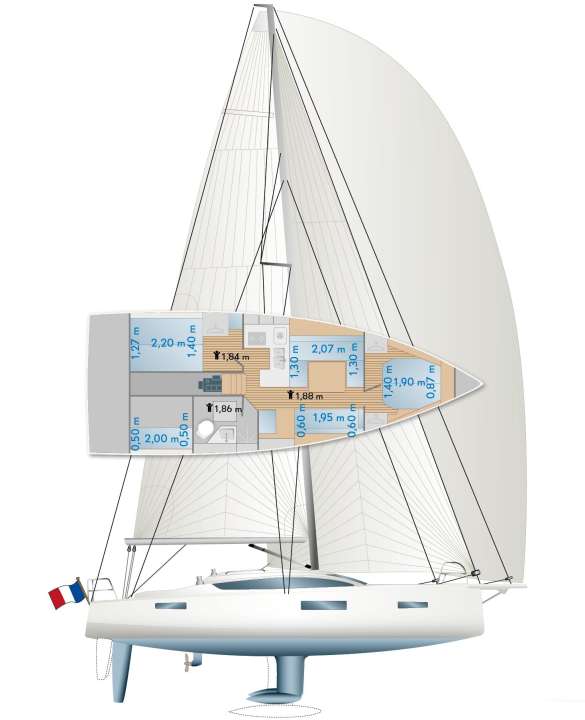
- CE design category A
- Hull length 10,80 m
- Total length 11,47 m
- Waterline length 10,15 m
- Width 4,00 m
- Draught/alternative 1,72/2,04 m
- Mast height above WL 17,20 m
- Th. torso speed 7.7 kn
- Weight 5,5 t
- Ballast/proportion (hours) 1,9 t/34 %
- Mainsail 39,0 m2
- Furling genoa (106 %) 39,0 m2
- Machine (Volvo P.) 21 kW/29 hp
- Fuel tank 80 l
- Fresh water tanks 2 x 150 litres
- Holding tank 50 l
Hull and deck construction
Hull plywood (Okoumé) as a multi-buckling frame with epoxy coating on the outside and inside. The deck is a GRP sandwich construction, built with vacuum infusion.
Motorisation
Built-in Volvo Penta D1-30 diesel with Saildrive propulsion and twin-blade fixed pitch propeller. A retractable bow thruster is available as an option (surcharge €14,270).
Rig and sail
Aluminium mast and main boom from manufacturer Z-Spars with wire shrouds (1:19). A cutter stay with backstays is available as an option. The surcharge for a carbon fibre rig with Dyform shrouds is €26,850. A set of Dacron sails (main and genoa) is included in the scope of delivery.
Shipyard
RM Yachts, F-17185 Périgny (France), www.rm-yachts.com
Distribution
Blue Yachting, Bremen, www.blue-yachting.de
The competition of the RM 1080
When it comes to performance cruisers, a good compromise is what counts. A selection of the very varied competition.
Beneteau First 36
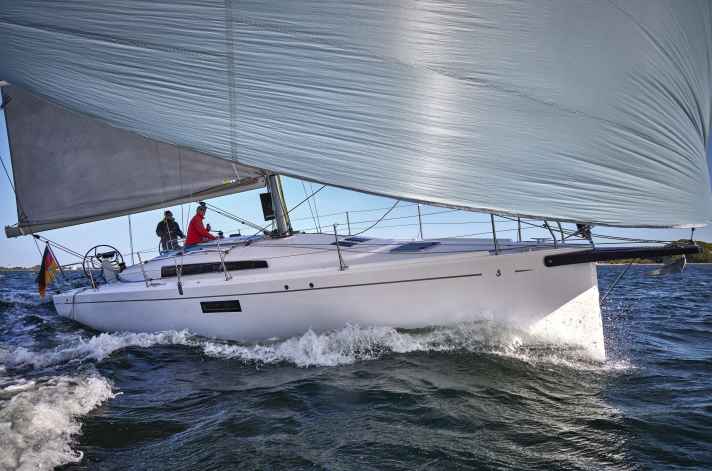
The competitor from the industry leader, built by Seascape. The design comes from Sam Manuard and shows a strong performance in the test, especially on rough courses.
To test the Beneteau First 36...
The First 36 in the big comparison of performance cruisers...
Dehler 38 SQ
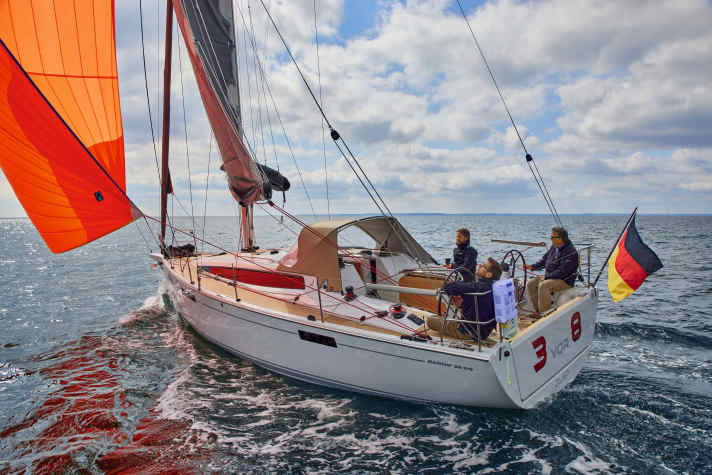
The successful yacht from the Greifswald series production is an attractive all-rounder. Her concept is straightforward and the boat is beautifully and cosily finished.
To the test of the Dehler 38 SQ...
The Dehler 38 SQ in the big comparison of performance cruisers...
Elan E4
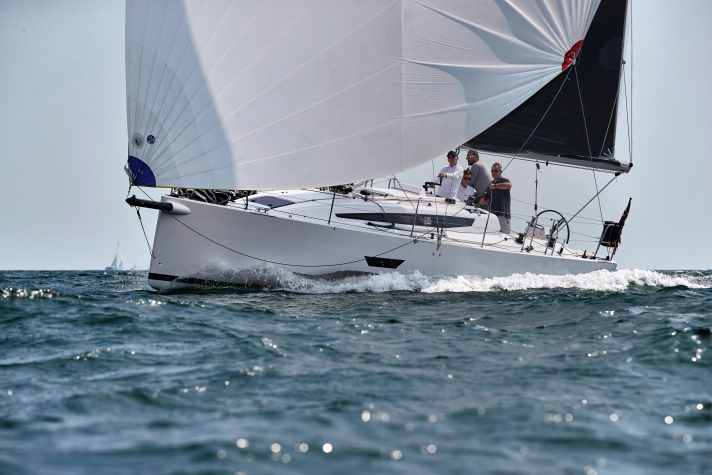
The round crossover concept comes from Slovenia and combines good and sporty sailing characteristics with plenty of living comfort below deck. The bowsprit for the gennaker is extendable.
Pogo 36
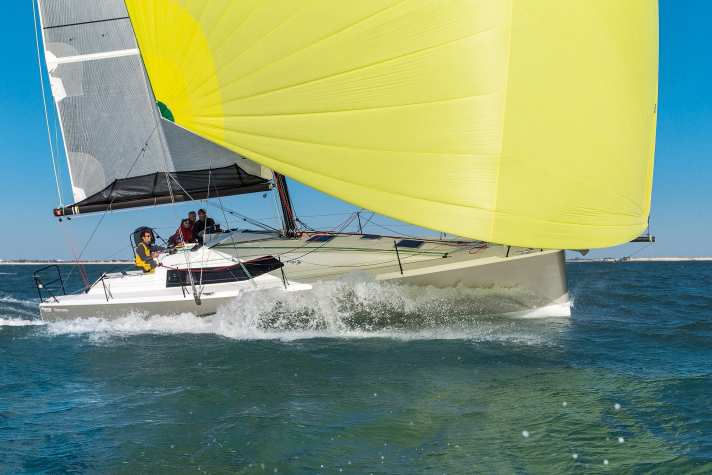
The wide fast cruiser from Brittany is very light. The boat is supplied with a swivelling keel as standard. Simple, but also very functional interior fittings.
To test the Pogo 36...


